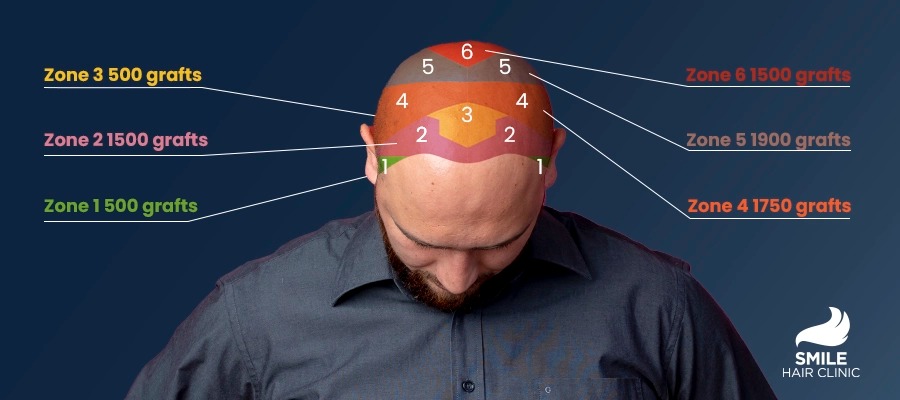How Many Grafts Do I Need For My Hair Transplant

How Many Grafts Do I Need For My Hair Transplant
Hair loss is a prevalent condition affecting individuals worldwide, with male pattern baldness being one of the most common manifestations. Over the years, advancements in medical technology have led to the development of hair transplantation techniques, offering hope to those seeking to regain a full head of hair. Central to the success of any hair transplant procedure is the determination of how many grafts do ı need for my hair transplant to achieve satisfactory results. This article delves into the intricate details of graft counts across various stages of hair loss as defined by the Norwood Hamilton Scale.
Understanding the Norwood Hamilton Scale:
The Norwood Hamilton Scale, initially devised by Dr. O’Tar Norwood in the 1950s and modified by Dr. James Hamilton, serves as a standardized classification system for male pattern baldness. This scale categorizes hair loss into distinct stages, ranging from minimal to extensive, thereby aiding in assessing and managing hair loss in men.
Type I:
Type I on the Norwood Hamilton Scale represents the earliest stage of male pattern baldness, characterized by minimal to no recession of the hairline. Individuals classified as Type I typically exhibit a full head of hair with no visible signs of hair loss. Hair transplantation may not be necessary for individuals in this category, as there is no significant hair loss to address.
Type II:
Type II marks the onset of hairline recession, albeit subtly. Individuals may notice a slight hairline downturn at this stage, often forming a triangular or wedge-shaped pattern. Hair transplantation for Type II individuals typically involves a conservative approach, with graft counts ranging from 500 to 1000 grafts. The goal is to restore the natural hairline while maintaining a natural-looking appearance.
Type III:
Type III represents a more pronounced stage of hair loss, characterized by significant recession at the temples, resulting in a distinct M-shaped pattern. Individuals in this category may also experience thinning at the crown area. Hair transplantation for Type III individuals typically requires a higher graft count, ranging from 1000 to 2000. The focus is restoring density to the frontal hairline and addressing thinning areas at the crown.
Type IV:
Type IV on the Norwood Hamilton Scale signifies further progression of hair loss, with noticeable recession at the temples and vertex. At this stage, individuals may experience a significant decrease in hair density, particularly in the frontal and crown regions. Hair transplantation for Type IV individuals often involves a more extensive approach, with graft counts ranging from 2000 to 3000 grafts. The aim is to restore a natural-looking hairline while providing adequate coverage to thinning areas.
Type V:
Type V marks a significant advancement in hair loss, with larger areas of baldness at the temples and crown. A thin bridge of hair may remain, separating the balding areas. Hair transplantation for Type V individuals necessitates a higher graft count, typically ranging from 3000 to 4000 grafts. The focus is on achieving comprehensive coverage and restoring a natural-looking appearance across the frontal and crown regions.
Type VI:
Type VI on the Norwood Hamilton Scale represents deepening recession at the temples and vertex, with sparse hair remaining on the bridge. Individuals in this category may exhibit extensive balding, requiring a more aggressive approach to hair transplantation. Graft counts for Type VI individuals typically range from 4000 to 5000 grafts or more. The goal is to achieve maximal coverage and density across the entire scalp, including the frontal, mid, and crown regions.
Type VII:
Type VII represents the most advanced stage of hair loss, characterized by severe balding, leaving only a band of hair along the sides and back of the scalp. Individuals classified as Type VII may have limited donor hair available for transplantation, necessitating a strategic approach to graft allocation. Hair transplantation for Type VII individuals may require a higher graft count, ranging from 5000 to 6000 grafts or more. The focus is on maximizing coverage and density while ensuring a natural-looking result.
Factors Influencing Graft Counts:
While the Norwood-Hamilton Scale provides a framework for estimating graft requirements, several factors can influence the final graft count in a hair transplantation procedure. These factors include:
- Hair Characteristics: The texture, color, and density of the patient’s donor hair are crucial in determining the number of grafts needed for adequate coverage.
- Desired Hairline: Patients’ preferences regarding the shape and density of their restored hairline can impact the graft count, with denser, more defined hairlines requiring additional grafts.
- Donor Area Availability: The availability of viable donor hair from the back and sides of the scalp influences the maximum number of grafts that can be harvested for transplantation.
- Surgeon Expertise: The skill and experience of the hair transplant surgeon significantly affect the efficiency of graft extraction and implantation, potentially minimizing graft wastage and maximizing coverage.
Hair transplantation offers a viable solution for individuals seeking to address male pattern baldness and restore a full head of hair. By understanding the nuances of the Norwood Hamilton Scale and its implications for graft allocation, hair transplant surgeons can tailor their approach to meet each patient’s unique needs. Through meticulous planning and execution, hair transplantation procedures can yield natural-looking results, enhancing appearance and self-confidence for individuals affected by hair loss.
 Whatsapp
Whatsapp
